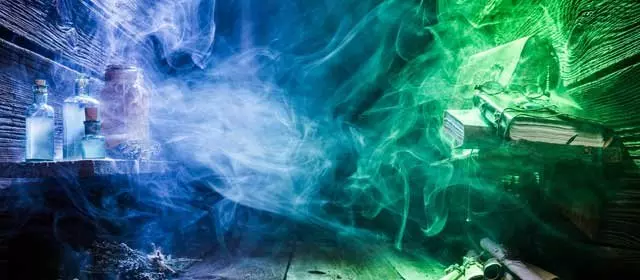If alchemy was born in China, 4 centuries before our era, it was then in ancient Greece and Egypt where it gained popularity in the West. It is the Arabic version that dominated Europe in the Middle Ages and then the Renaissance. Until the 18th century, chemistry and alchemy were intimately intertwined. It is only from the great scientific discoveries in chemistry that the two disciplines have split up, separating more and more the indisputable, replicable and quantified phenomena of a theory that has not yet given, to our knowledge, any proven concrete results.

Paracelsus, often cited in the list of great alchemists, has in fact concentrated on the medical use and the philosophical aspect of this discipline. It replaces the 4 elements by three substances: sulfur, mercury and salt. He compared the process of digestion to alchemy, the science of cooking and maturing.
For the alchemist, it involves transforming metals, such as transforming lead or other "base" metals into noble metals like gold and silver. This composes an elixir of long life and develops a panacea that would cure all diseases. Alchemy is connected to astrology through its symbolism. Indeed, the alchemists consider that the sun gives gold, the moon gives silver, Mercury gives mercury, Venus gives copper, Mars gives iron, Jupiter gives tin and Saturn gives lead.
One of the great mysteries of alchemy remains, today, the nature and composition of this famous philosopher's stone supposed to transform base metals into gold or silver. In 1618, Jean-Baptiste Van Helmont describes this mysterious stone: "I saw and touched the philosopher's stone more than once, the color was like saffron powder, but heavy and shiny like powdered glass.This product, a quarter grain (13.25 mg) furnishes eight ounces of gold (244.72 g) and exhibits considerable energy: about 18,470 times the unit. "
The techniques to achieve transmutation are particularly obscure, detailed methods of enormous complexity are subject to infinite interpretations. The reading of alchemy treatises is a real initiatory ordeal: the masters expected their students to surpass their intellectual and spiritual capacities to aspire to enlightenment. However, certain alchemical experiments that have remained unexplainable for so long and are therefore "magical" and can be explained today by contemporary chemistry.
- Alchemists have helped to identify mineral acids such as nitric acid, sulfuric or hydrochloric acid. We owe them the regal water, capable of dissolving gold, vitriol, etching, spirit-of-salt, spirit-of-wine (ethanol) ...
- They discovered certain elements unknown until now: antimony, arsenic, bismuth or phosphorus.
- They invented original chemical compounds: alum, borax, ether, minium, salts of lead, iron, silver ...
- They experimented with the phosphorescence of barium sulphide ...
- The alchemists have also, during their experiments, developed new tools: crucibles, retorts, bain-marie, scales ...
They have developed very inventive methods still used today such as, filtration, distillation, alloying, purification, crystallization, sublimation, metallurgy ... Mercury-treated gold bleaches can be mistaken for silver or tin. Mercury, charged with zinc and red copper, may give it the appearance of gold, and the etchings used in operations contained dissolved gold and silver.
Finally, nowadays, alchemy can be considered as a personal, philosophical and symbolic search. One seeks to find oneself, one builds bridges between the conscious (the matter) and the unconscious (the transmutation). Alchemy is no longer really a science but a spiritual exercise that can help us see things hidden behind or in other things.






